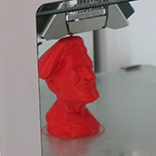November 22, 2013 — Additive manufacturing, more commonly known as 3-D printing, is among the many world-saving ideas favored by techies, as well as by a general population enamored with the next cool thing that seems likely to translate well out of the lab and into society at large. But is additive manufacturing any better for the planet than traditional subtractive manufacturing? Recently, as we’ve written about previously, researchers at Michigan Technological University found that the answer is yes, and now analysts at the Department of Energy’s Oak Ridge National Laboratory agree.
The difference between “additive” and “subtractive” is important, the ORNL researchers found. Manufacturing cabin brackets on airplanes from titanium using computer-aided software that optimizes the design and then prints in 3-D saved a manufacturer 1.56 pounds of titanium per bracket because the process built them from titanium powders instead out of titanium ingots. That may not seem like a lot — until you multiply it by the number of brackets involved. “Some of the more basic technical cabin systems have more than 250,000 [brackets] installed,” says Sachin Nimbalkar, a scientist at ORNL. When the researchers then looked at the life cycle of the different manufacturing processes, they found 3-D printing helped reduce carbon dioxide emissions per plane by 4,141 metric tons over a plane’s 30-year lifespan in part due to lower fuel demand from the lighter planes.
Photo by edenpictures (Flickr | Creative Commons)
Ensia shares solutions-focused stories free of charge through our online magazine and partner media. That means audiences around the world have ready access to stories that can — and do — help them shape a better future. If you value our work, please show your support today.
Yes, I'll support Ensia!

